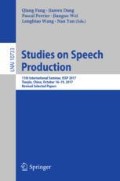Abstract
There are five tones in Nanjing Dialect, including four open-syllable tones and one entering tone with a syllable-final glottal stop, which is not found in Beijing Mandarin. Each checked syllable normally corresponds to an open syllable with the same vowel but different tones. This study focuses on the acoustic comparisons of the two kinds of syllables to discuss the acoustic discrepancies between checked and open syllables in Nanjing Dialect, specifically with regards to vowel quality. The acoustic parameters include the duration, the first formant (F1), the second formant (F2), and the third formant (F3) of the vowels. The results of vowel duration indicate that the entering tone is still the shortest among the five tones. The relatively higher F1, F2 and F3 in the entering tone suggest the effect of a glottal stop coda on the vowel quality.
Access this chapter
Tax calculation will be finalised at checkout
Purchases are for personal use only
Notes
- 1.
Here the reference of p value for multiple comparisons was not adjusted since Perneger [10] argued that this kind of downward adjustment is overly conservative.
References
Chao, Y.: The phonology of Nanjing Dialect. J. Sci. 13, 1005–1036 (1929)
Chao, Y.: A system of tone letters. Le Maître Phonétique 45, 24–27 (1930)
Sun, H.: A discussion on tones of Nanjing Dialect. J. Nanjing Xiaozhuang Univ. 19, 34–40 (2003)
Song, Y.: On experiment of entering tones in Nanjing Dialect. J. Sch. Chin. Lang. Cult. Nanjing Norm. Univ. 11, 166–172 (2009)
Sun, H.: A discussion on light tone and entering tone in Nanjing Dialect. J. Jiangsu Second. Norm. Univ. 17, 67–68 (2001)
Chen, S., Wiltshire, C.: Tone realization in younger versus older speakers of Nanjing Dialect. In: Jing-Schmidt, Z. (ed.) Increased Empiricism: Recent Advances in Chinese Linguistics, pp. 147–170. Benjamins, Amsterdam and Philadelphia (2003)
Liu, D.: Nanjing Dialect Dictionary. Jiangsu Education Publisher, Nanjing (1995)
Xu, Y.: ProsodyPro — a tool for large-scale systematic prosody analysis. In: TRASP 2013, Aix-en-Provence, France, pp. 7–10 (2013)
Xu, Y.: FormantPro.praat (2007–2015). http://www.phon.ucl.ac.uk/home/yi/FormantPro/
Perneger, T.: What’s wrong with Bonferroni adjustments. BMJ 316, 1236–1238 (1998)
Yan, T.: The physiological characteristics of syllables with entering tones in Chinese dialects — the diachronic change of entering tones. Lang. Linguist. China 1, 523–537 (1992)
Catford, J.: Pharyngeal and laryngeal sounds in Caucasian language. In: Bless, D.M., Abbs, J.H. (eds.) Vocal Folds Physiology: Contemporary Research and Clinical Issues, pp. 344–350. College Hill Press, San Diego (1983)
Lagefoged, P., Maddieson, I.: The Sounds of the World’s Languages, pp. 310–313. Blackwell Publishers, Oxford (1996)
Johnson, K.: Acoustic and Auditory Phonetics, pp. 137–141. Blackwell Publishers, Oxford (2012)
Acknowledgement
This work was supported by the National Science Foundation of China (61573187) and Humanity and Social Science Foundation of Ministry of Education of China (18YJA740007).
Author information
Authors and Affiliations
Corresponding author
Editor information
Editors and Affiliations
Rights and permissions
Copyright information
© 2018 Springer Nature Switzerland AG
About this paper
Cite this paper
Yang, Y., Chen, Y. (2018). Effects of Entering Tone on Vowel Duration and Formants in Nanjing Dialect. In: Fang, Q., Dang, J., Perrier, P., Wei, J., Wang, L., Yan, N. (eds) Studies on Speech Production. ISSP 2017. Lecture Notes in Computer Science(), vol 10733. Springer, Cham. https://doi.org/10.1007/978-3-030-00126-1_14
Download citation
DOI: https://doi.org/10.1007/978-3-030-00126-1_14
Published:
Publisher Name: Springer, Cham
Print ISBN: 978-3-030-00125-4
Online ISBN: 978-3-030-00126-1
eBook Packages: Computer ScienceComputer Science (R0)

